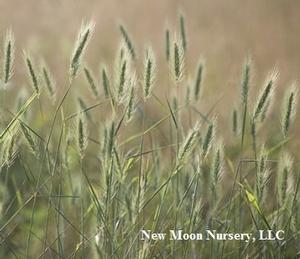Printed at http://www.newmoonnursery.com/index.cfm/
Elymus virginicus
Virginia wild rye
Native to North America
FIRST IMPRESSIONS: Elymus virginicus is a clump forming cool season perennial grass. The tufted foliage is narrow and evergreen or semi-evergreen. Blades have a green or silver blue color and a waxy sheen. Bristly wheat-like spikey flower with hair like awns form in late spring. They are held above the foliage undergoing a color transformation from green to buff as the seed mature. This grass thrives in sunny or partly shaded exposures in moist or wet sites.
HABITAT & HARDINESS: Elymus virginicus occurs in the southern Canadian provinces, south from Maine to Florida and west to North Dakota, Wyoming and Arizona.
This species is indigenous to deciduous bottomland forest, rocky limestone glades, bluffs, savannas, moist prairies, edges of marshes, river and creek banks, fields, roadsides and other disturbed areas.
This grass is hardy from USDA Zones 3-8.
PLANT DESCRIPTION: Elymus virginicus is cool season bunchgrass with a mounding habit.
Leaves are linear and arching with pointed tips. They are almost ½” wide and up to 12” long. They are borne in gray green or blue-green clumps.
Several culms rise above each foliage clump. Each bears erect 3-6” spike like racemes. The racemes are densely packed with ascending spikelets with long hair like awns.
The wheat-like inflorescences transform from green to golden brown as they mature. The flower and fruit display is striking through summer and into autumn as the seedheads sway in the breeze.
Plants attain 2-4’ height with 1-2’ spread.
CULTURAL & MAINTENANCE NEEDS: Elymus virginicus prospers in sunny sites with fertile loamy or clay soils.
This grass tolerates many types of soil but tends to favor heavy rich soil. Plants are easy to grow if enough moisture is present.
In garden situations, plants self-seed with abandon. If this is an issue, deadhead the inflorescences before seed mature. Old foliage and seed stalks can also be cut to the ground in late winter to provide a blank slate for fresh new growth.
Young plants are occasionally nibbled by deer but this resilient grass recovers quickly.
LANDSCAPE USES: Elymus virginicus has Showy Flowers and Attractive Seedheads that allow it to serve as a lovely Accent, Grouping or Mass. Plants provide Erosion Control and Winter Interest. Plants are useful Cut Flowers and are appropriate for Low Maintenance Plantings, Meadow Gardens, margins of Water Gardens, Restoration Projects, Rain Gardens, Stormwater Management Systems and Wildlife Gardens.
COMPANION & UNDERSTUDY PLANTS: Try pairing Elymus virginicus with Chasmanthium latifolium, Eupatorium coelestinum, Heliopsis helianthoides, Liatris spicata, Monarda fistulosa or Phlox paniculata.
If a substitute is needed, Chasmanthium latifolium has coarser texture but similar height and cultural needs.
TRIVIA: Elymus virginicus hosts caterpillars of several species of branded skippers, satyrs and several types of moths. Plants provide seed to birds and small rodents. Grazing animals feed on the foliage early in the season. Later in the year, the bristly flowers can cause injury to browsers. Seed heads can also become infested with the fungus ergot which is toxic to livestock.
Can be differentiated from the very similar Elymus canadensis because E. canadensis has a drooping or nodding inflorescence while Elymus virginicus has an upright erect inflorescence. E. virginicus generally occurs in moister sites and is more tolerant of shaded exposure.
Height:
2-4 ftSpread:
1-2 inSpacing:
18-24 inUSDA Hardiness Zone:
3-8Bloom Color:
Green, TanElymus virginicus Characteristics
Attributes
- Bog
- Naturalizing
- Interesting Foliage
- Rain Garden
- East-Coast Native
- Drought Tolerant
- Dried Flower
- Clay Soil
Exposure
- Full Sun to Partial Shade
Flowering Months
- August
Foliage Color
- Green
Grass Season
- Cool Season Grass
Phytoremediation
- Hydrocarbons
Soil Moisture Preference
- Wet to Moist
Interesting Notes:
For more information on this plant, visit the USDA PLANTS Database: http://plants.usda.gov/java/profile?symbol=elvi3

